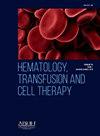ACUTE MYELOID LEUKEMIA PRESENTING AS ACUTE PANCREATITIS WITH MULTISYSTEM LEUKEMIC INFILTRATION: A CASE REPORT OF PANCREATIC, BILIARY TRACT AND PULMONARY INVOLVEMENT
IF 1.8
Q3 HEMATOLOGY
引用次数: 0
Abstract
Objective
Acute myeloid leukemia (AML) classically presents with symptoms related to anemia, infections, or bleeding. However, atypical presentations involving abdominal pain, acute pancreatitis, and biliary ducts infiltration are rare but have been documented. These unusual manifestations can complicate the diagnosis and delay recognition of AML. Here, we present a case of a young female patient diagnosed with AML, who initially presented with acute pancreatitis and subsequent findings suggestive of biliary tract infiltration and possible pulmonary involvement.
Case Report
A 22-year-old female with no notable medical history presented to a local healthcare facility with abdominal pain and diarrhea. She was diagnosed with acute pancreatitis based on clinical evaluation. Abdominal ultrasonography revealed a mass at the head of the pancreas, along with dilatation of both intrahepatic and extrahepatic bile ducts. The patient was referred to Dicle University Educational Hospital for further investigations, including endoscopic retrograde cholangiopancreatography (ERCP). Upon admission to the general internal medicine clinic, the pancreatic mass and biliary duct dilation were confirmed, and further laboratory investigations showed an elevated white blood cell count as 24.900/mm3. A peripheral blood smear demonstrated abnormal white cells, raising suspicion of a hematologic disorder. A bone marrow biopsy was subsequently performed, confirming the diagnosis of AML. Magnetic resonance cholangiopancreatography (MRCP) was conducted to further assess the pancreatic and biliary tract lesions, revealing findings consistent with extramedullary hematologic infiltration. The patient was started on the 7+3 chemotherapy regimen (cytarabine 200 mg/m2 for 7 days and an idarubicin 12 mg/m2 for 3 days). Following treatment, her abdominal pain and distension improved, and laboratory abnormalities normalized, but She died because of neutropenic sepsis during 35th day of treatment.
Conclusion
AML can exhibit extramedullary involvement of any organ, though pancreatic, biliary tract, and hepatic enzyme abnormalities are rare and occurs in approximately 8–10% of cases. A study from one center indicated that the most common sites of extramedullary AML involvement are the skin (65%), the central nervous system (23%), and the pleura (7%) . Multi-organ involvement has been reported in around 9% of cases, but pancreatic and biliary duct infiltration is extremely rare, accounting for only 1% of cases. In our case, the patient exhibited involvement of the pancreas, biliary tracts, spleen, and lungs, a situation that is exceedingly rare, with no similar cases found in the existing literature.
求助全文
约1分钟内获得全文
求助全文
来源期刊

Hematology, Transfusion and Cell Therapy
Multiple-
CiteScore
2.40
自引率
4.80%
发文量
1419
审稿时长
30 weeks
 求助内容:
求助内容: 应助结果提醒方式:
应助结果提醒方式:


